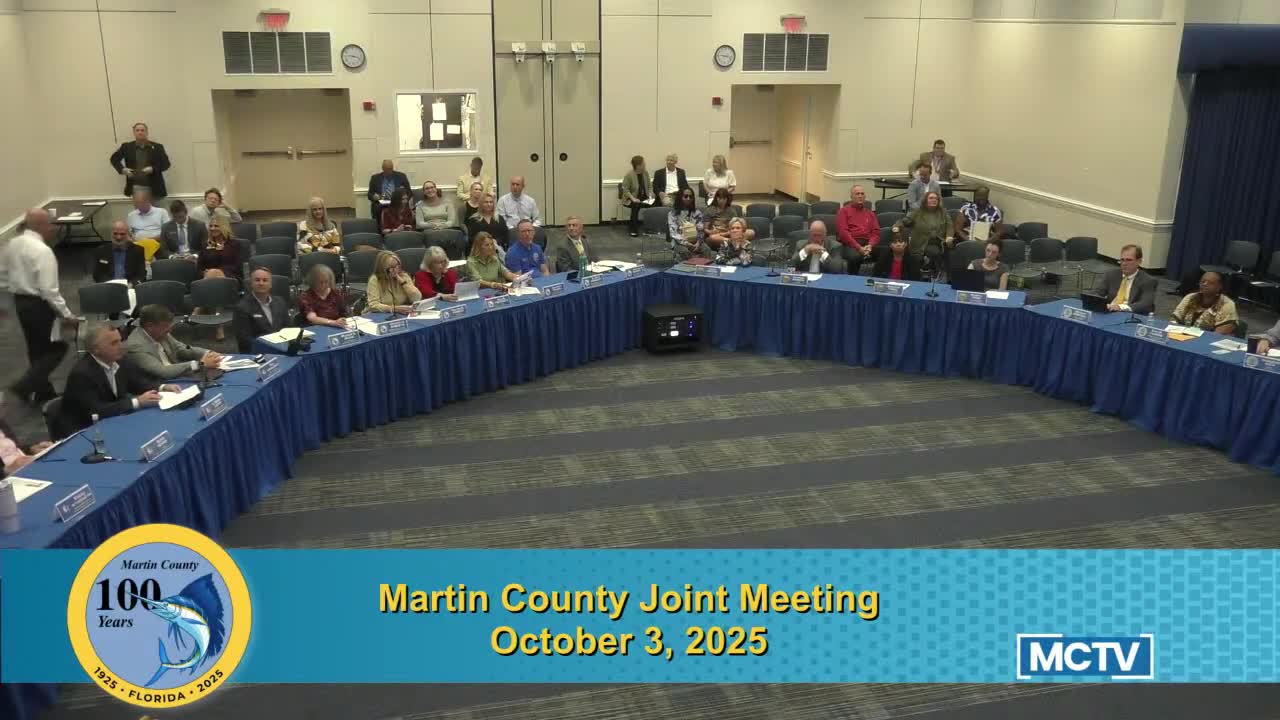Indiantown leaders outline wastewater plant expansion, RO plant plans and deep injection well; county appropriations cited
October 04, 2025 | Martin County, Florida
This article was created by AI summarizing key points discussed. AI makes mistakes, so for full details and context, please refer to the video of the full meeting. Please report any errors so we can fix them. Report an error »

Pat Nolan, director of utilities and public works for the Village of Indiantown, updated the joint meeting on a slate of water and wastewater projects the village is pursuing and the funding gaps that remain.
Nolan said the new Indiantown wastewater plant will be sized for 1,200,000 gallons per day with quick expansion capacity of another 600,000 gallons; he said the existing plant handled about 750,000 gallons a day. The wastewater plant construction is moving forward with anticipated completion in June 2026, Nolan said.
Nolan described a package of related projects and costs: the wastewater plant’s current estimate is about $26,000,000 (he said the original estimate was $14,000,000); the village has received $76,000,000 in appropriations from the governor’s office to be applied to infrastructure across the village.
He said the village is drilling three ‘Florida’ (brackish) wells this week and that outfitting each Florida well may cost $1–2 million. He said three “Bridal” wells (term used in transcript) were contracted at about $2,200,000 each. Nolan described a planned RO (reverse‑osmosis) plant to treat brackish water and noted the RO process creates a concentrate that must be disposed of safely; for that purpose the village is building a deep injection well drilled to about 3,300 feet. Nolan estimated the deep injection well construction cost at roughly $5,000,000 and said the project will be co‑located at the wastewater plant per South Florida Water Management District recommendations to increase funding attractiveness and serve as an emergency disposal option.
Nolan said the village received State Revolving Fund (SRF) design funding for upgrades to the existing water plant (he cited $12,300,000 in SRF funding) and that other on‑site improvements include a reuse facility rehab (~$1.2 million) and lift stations previously completed (~$1.2 million mentioned earlier). He also described other specific items: three new Bridal wells have been contracted, and installation of deep injection well testing informed drilling depth choices; testing indicated the best water production around 800 feet for the Florida wells, saving drilling costs compared with an earlier plan to go to about 1,100 feet.
Nolan emphasized the village is actively seeking grant and state funding to complete projects, repeatedly noting funding remains the primary constraint. He said many projects were designed and will start when financing is in place.
Nolan said the new Indiantown wastewater plant will be sized for 1,200,000 gallons per day with quick expansion capacity of another 600,000 gallons; he said the existing plant handled about 750,000 gallons a day. The wastewater plant construction is moving forward with anticipated completion in June 2026, Nolan said.
Nolan described a package of related projects and costs: the wastewater plant’s current estimate is about $26,000,000 (he said the original estimate was $14,000,000); the village has received $76,000,000 in appropriations from the governor’s office to be applied to infrastructure across the village.
He said the village is drilling three ‘Florida’ (brackish) wells this week and that outfitting each Florida well may cost $1–2 million. He said three “Bridal” wells (term used in transcript) were contracted at about $2,200,000 each. Nolan described a planned RO (reverse‑osmosis) plant to treat brackish water and noted the RO process creates a concentrate that must be disposed of safely; for that purpose the village is building a deep injection well drilled to about 3,300 feet. Nolan estimated the deep injection well construction cost at roughly $5,000,000 and said the project will be co‑located at the wastewater plant per South Florida Water Management District recommendations to increase funding attractiveness and serve as an emergency disposal option.
Nolan said the village received State Revolving Fund (SRF) design funding for upgrades to the existing water plant (he cited $12,300,000 in SRF funding) and that other on‑site improvements include a reuse facility rehab (~$1.2 million) and lift stations previously completed (~$1.2 million mentioned earlier). He also described other specific items: three new Bridal wells have been contracted, and installation of deep injection well testing informed drilling depth choices; testing indicated the best water production around 800 feet for the Florida wells, saving drilling costs compared with an earlier plan to go to about 1,100 feet.
Nolan emphasized the village is actively seeking grant and state funding to complete projects, repeatedly noting funding remains the primary constraint. He said many projects were designed and will start when financing is in place.
View full meeting
This article is based on a recent meeting—watch the full video and explore the complete transcript for deeper insights into the discussion.
View full meeting